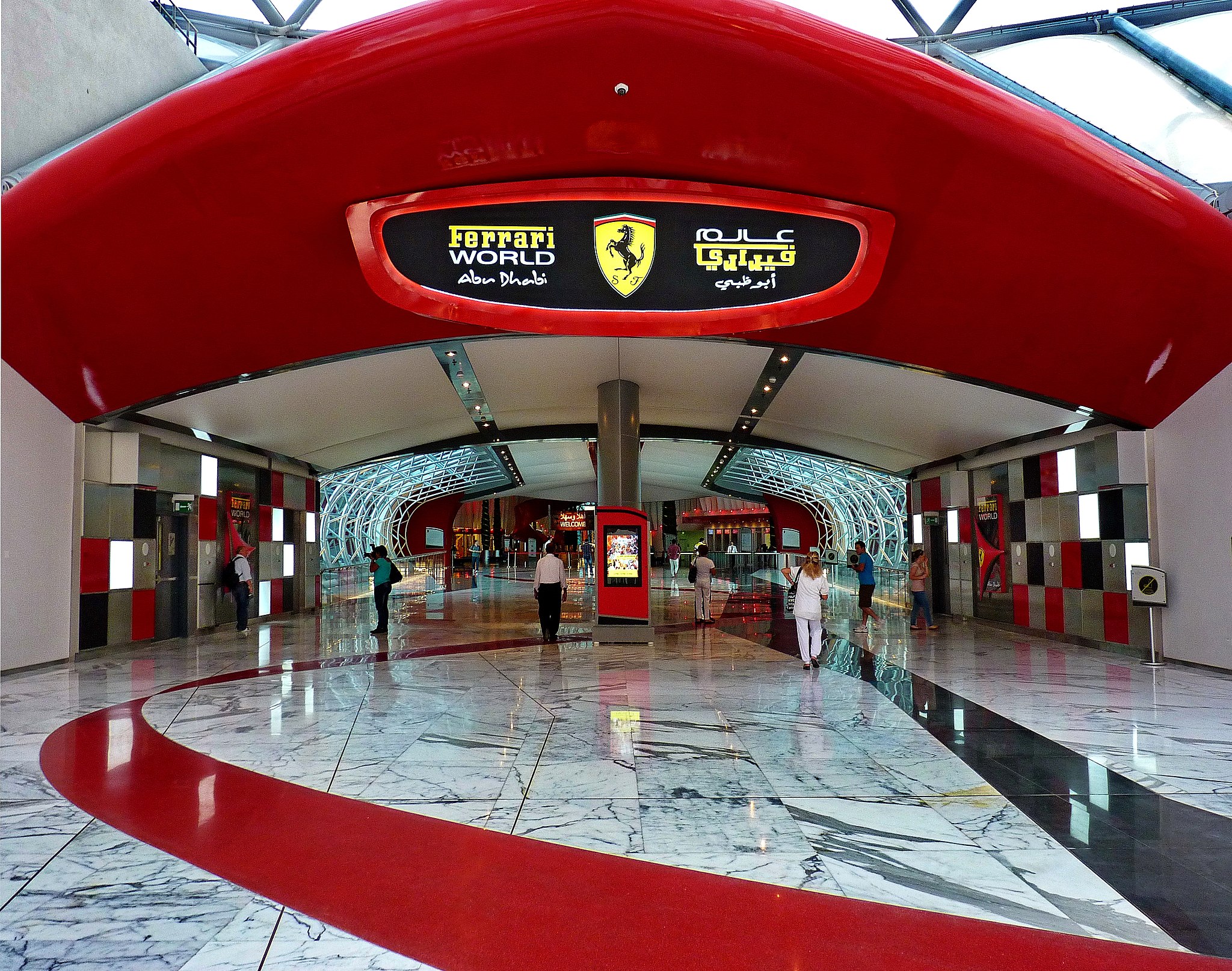The Middle East is a burgeoning region for commercial development with governments and private companies initiating major projects. Qatar, which has built seven new stadiums for the upcoming 2022 FIFA World Cup, has a pipeline of projects valued at $230 billion.
The Gulf region in particular will experience a dramatic change in the coming years with many planned megaprojects, including the $1.3 billion Jeddah Tower (Saudi Arabia) and the 450-store Reem Mall (UAE). These structures, once completed, will join the following facilities on the list of the most impressively designed buildings in the Middle East.
1. Ferrari World (UAE)
Contrasting the desert region that surrounds the building is a giant, triangular, bright-red structure known as Ferrari World. Located on Yas Island in Abu Dhabi, the world’s second-largest indoor theme park is equivalent in size to about seven football fields and is shaped like a UFO. It is the first and only Ferrari-branded theme park in the world, and it is home to the world’s largest Ferrari logo.
Construction on Ferrari World began in 2008 and the project was completed within two years for $40 billion. For reference, that’s twice as much as it cost to construct the entire Downtown Dubai complex, which includes the world’s tallest building: the Burj Khalifa. There are 21 rides, including the world’s fastest roller coaster, inside the iconic, climate-controlled structure. Ferrari World also showcases racing memorabilia, hosts live shows, and has several authentic Italian restaurants.
2. Cayan Tower (UAE)
Although it sits outside of the top 100 tallest buildings in the world, the 306-meter Cayan Tower in Dubai is among the world’s most distinct and recognizable buildings. Also called the Infinity Tower, the 80-story building is an architectural marvel with a twisting design that rotates 90 degrees from its base to its peak. More impressively, it isn’t supported by pillars. It is the world’s highest spiraling tower.
Construction for the $272 million project began in 2006 and concluded in 2013. Skidmore, Owings & Merrill designed the 75-story building with each floor rotating 1.2 degrees around a service core and cylindrical elevator.
3. Bahrain World Trade Center (Bahrain)
Like Cayan Tower, the World Trade Center in Bahrain is an incredible structure with unique elements. The $150 million project features a pair of parallel 50-story, 240-meter-tall buildings linked by three sky bridges. It is also the world’s first skyscraper with wind turbines. These turbines can generate as much as 15 percent of the facility’s electricity requirements due to the towers’ unique sail shape. Construction for the World Trade Center spanned four years and concluded in 2008.
Bahrain World Trade Center tenants include Ernst & Young, Elham Ali Hassan & Associates, and Bahrain Institute for Pearls & Gemstones. The towers also house a luxury mall with major international fashion brands as well as a range of cafes and restaurants.
4. National Museum of Qatar (Qatar)
Designed by French architect Jean Nouvel, the National Museum of Qatar looks like no other building in the Middle East. Located on the Doha Bay, the LEED Gold museum is punctuated with a “desert rose” roof consisting of 539 intersecting disks. Hundreds of architects and engineers collaborated on the design of the project and its intricate roof, while more than 2,500 laborers constructed the building.
“In its outlandishness, the National Museum of Qatar has loudly proclaimed the country’s might and ambitions, looking to culture and, specifically, architecture as a way of securing a place on the world stage,” commented Beth Broome in a feature on the building for Architectural Record.
The interior of the museum showcases the history and culture of the Qatari people in three segments: Beginnings, Life in Qatar, and The Modern History of Qatar. The museum has 11 galleries and nearly 1 mile of rooms.
5. Karim Khani Nook (Iran)
In contrast to the aforementioned modern buildings bustling with activity, the Karim Khani Nook at Golestan Palace in Tehran, Iran, is a calm and meditative space set against the backdrop of delicately manicured gardens. Designed to serve as a place of quiet contemplation, the building was constructed in 1759 and was formerly owned by Karim Khan of the Zand dynasty. It is among the oldest monuments in Tehran.
6. National Assembly Building (Kuwait)
Designed by Danish architect Jørn Utzon and constructed in 1972, the National Assembly Building in Kuwait City is the official seat of the Parliament of the State of Kuwait. After achieving independence, the country commissioned Utzon to design the intricate structure as part of its plan to develop new public administration buildings.
Utzon designed a unique structure based on a walled miniature city with departments, accessible via a central hall, situated around courtyards. It has two wide-span roofs that were placed into position via “railway tracks.” Utzon drew inspiration for the roof design from Arabian Bedouin tent construction.

